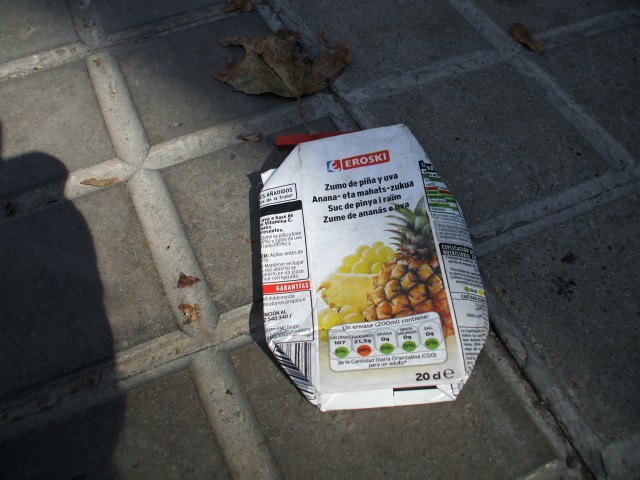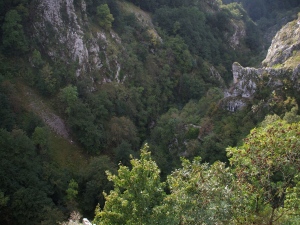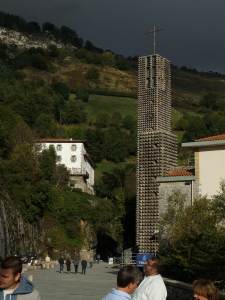NOTE: This was written two days ago. I’ve had internet access issues, so it’s taken a while to post. Hopefully I’ll get some additional writing from the past two days up very soon. Please stand by…
I’m already overwhelmed.
I didn’t sleep much on my flights, An enthusiastic young kid sitting next to me who kicked and elbowed me several hundred times, but made up for it by covering my lap with part of his blanket. I had an eight hour layover in Barcelona, so I took the train into town to check out this amazing city. I attended a Spanish mass, dipped my feet in the Mediterranean, boggled at Gaudi’s La Sagrada Familia and other architecture, and saw my first piece of co-op litter.

the first sign of Spain's cooperatives
I should explain that last bit: I am in Spain to visit Mondragon, and the huge system of worker-owned cooperatives based here. Among their many achievements is the creation of Spain’s second-largest chain of grocery stores, called Eroski (which means “group buying” in Basque). Barcelona has dozens of locations, yet I somehow managed to miss any sign of them beyond this juice box on the sidewalk. And yes, I picked it up after I snapped a photo.
In Bilbao, I met my cohort at a hotel that is part of Best Western, a U.S. based marketing co-op; it struck me as ironic that this would be our first co-op. After a brief orientation, we went out for an intense dinner that lasted from 8:30 to midnight, followed by several hours at a discotheque. I had none of my usual jet-lag insomnia.
Before we left Bilbao, I stopped by the Guggenheim Museum. It is an amazing structure by any standard, but I had a special appreciation for it because this morning I learned that it was built by the Mondragon cooperatives. Gehry’s concept was converted to a specific design by a co-op, the general contractor was a co-op, most of the subcontractors were co-ops, and the steel beams and titanium skin were even manufactured by a co-op. By working together as a consortium, they were able to take on a huge and complex project.

me and co-op steel
The Basque Country is the most affluent region in Spain, with an income level roughly 40% above the European average. This was clear pretty quickly. While I saw numerous people begging in Barcelona, I didn’t see any in Bilbao. But the area’s wealth became even more apparent after we left the city, where the co-ops are a relatively minor influence.
It is a rugged country, which reminds me a lot of the coast of northern California. It is not without old scars from the severe recession and deindustrialization that hit Spain in the 1980s – I saw several abandoned factories with grass growing on their roofs, and one large furniture store going out of business from the current crisis. But there appears to be generally good health, and the freeways are amazing; the main route to Mondragon is more tunnels than surface roads for about 20 km.
We left the highway and headed up a typical curvy scenic mountain road alongside a small lovely river, toward the town of Onati. But then something funny happened: We passed a large new factory. Then another. Then another. And so on. This beautiful, remote town had a healthy manufacturing sector, with close to a dozen new or recently expanded factories, most of which were facilities of two cooperatives, Fagor and Ulma.
To really understand how this all applies to my own region, I have been mentally comparing the Basque Country to the area roughly encompassing the Sacramento area to Lake Tahoe, between US50 and I-80. The Basque Autonomous Community is roughly the same size and a somewhat larger population (3 million). The closest parallel I can imagine to Onati would be if Placerville had a vibrant and growing manufacturing sector.
We continued past Onati to our hotel for the next four nights. It is not part of a co-op, but I’m going to let that slide because it is in one of the most powerful settings I have ever encountered. It is perched above a gorgeous mountain canyon, with a view of one of the Basque Country’s highest ridges, which features a line of giant wind turbines that somehow only added to the beauty. I highly recommend the Hotel Sandika, room 218, for anyone not afraid of heights – our balcony overlooks a gorge hundreds of feet deep, facing a stunning cliff that is literally closer to our room than the bottom. I hope they don’t have earthquakes here.

down

the cliff
We are in Arantzazu, which is a major Basque spiritual center. It is also home to the most amazing church I’ve ever seen. The structure is a collaboration of several giants of Basque contemporary art, and it is just stunning. The name means “in the thorns” and it is quite apt for this prickly masterpiece. I couldn’t bring myself to take any pictures of the inside; it was too powerful.
It is also currently being renovated by the co-op Ulma and one other firm.
These co-ops are everywhere, and tomorrow, finally, we are going to the place it all began. Just over 50 years ago, five graduates of Father Arizmendi’s community-based trade school bought the license to open a factory making paraffin stoves. Now they’ve got a model for the world. I’ve wanted to see this for years, and for the next week I’ll be immersed in it.


As I understand it, this site has been a church for much longer than the current installation. Apparently, it is the spot where St. Ignatius Loyola (founder of the Jesuit movement) took his vow of celibacy. The Jesuits were and are gifted educators. Not only was Arrizmendiaretta a Jesuit, but so was Moses Coady (founder of the Maritime Co-op movement). The Jesuits were also active in Paraguay during the height of the Empire creating worker collectives among the Guarni as a means of bringing them into Christianity. In a sense, this mountain church is a major incubator of modern co-operation.
Pingback: Appalachia and the Basques « Cooperate and No One Gets Hurt